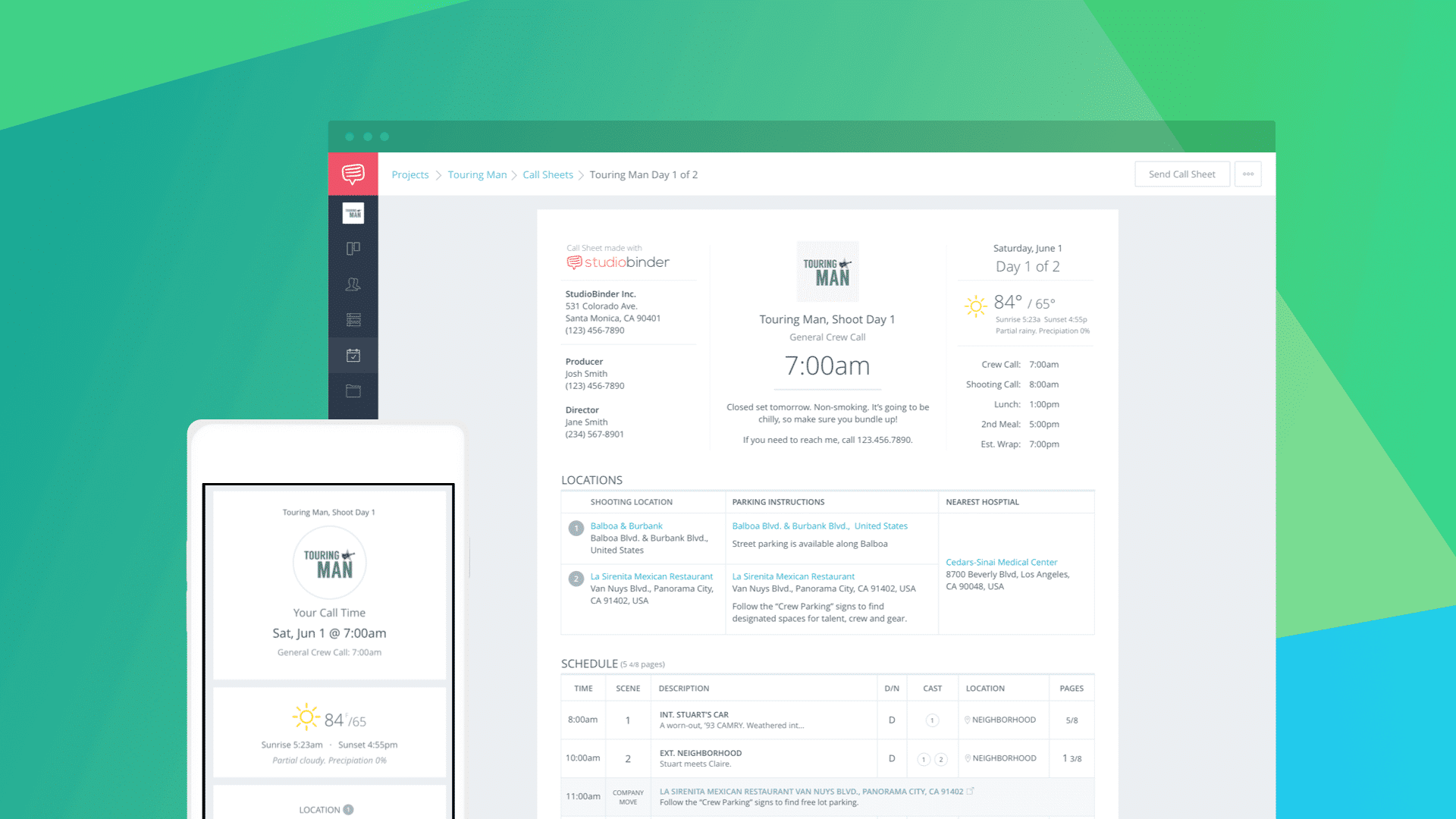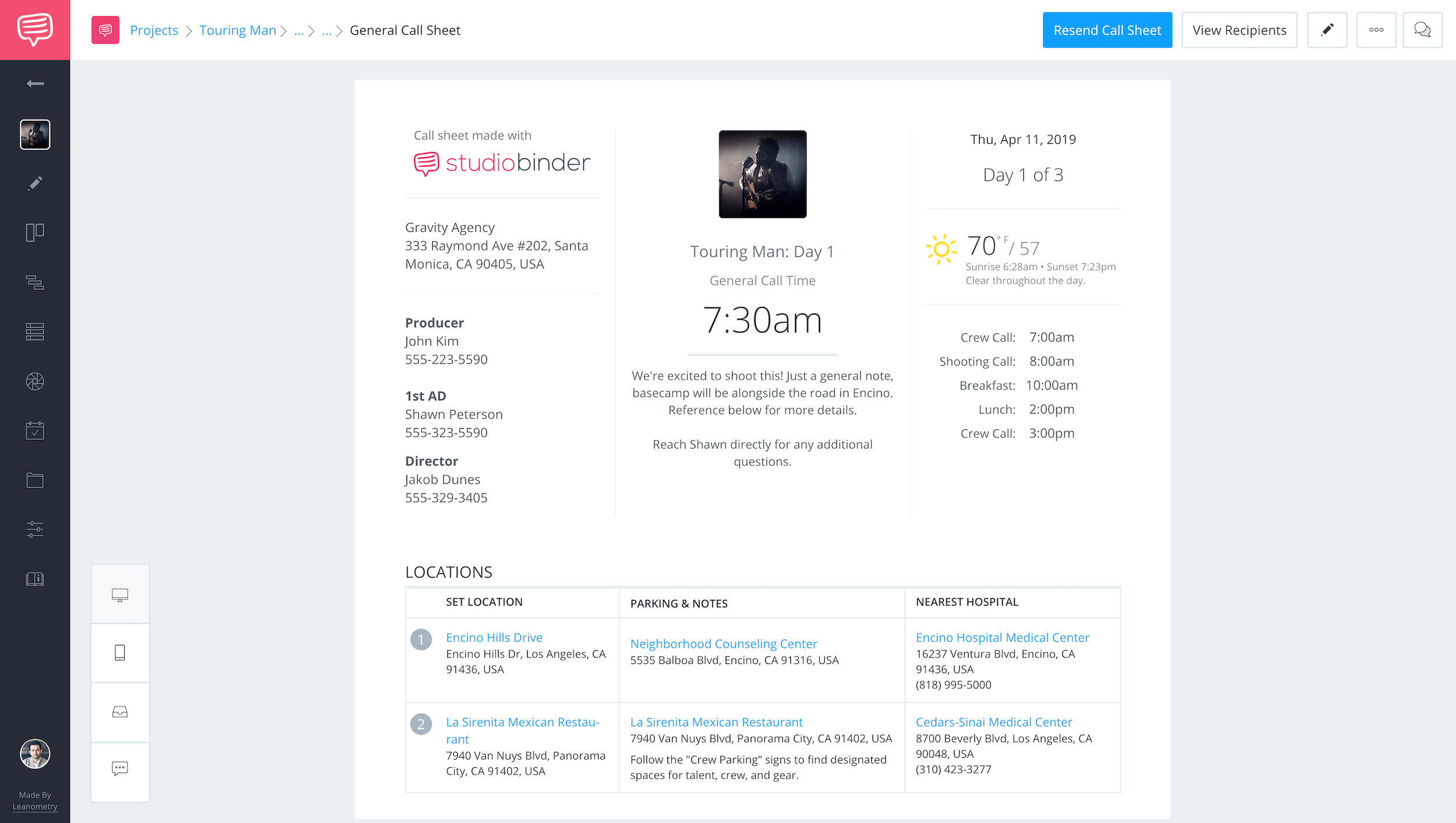You may have heard the term “call sheet” many times. But if you’ve never sent one out yourself, you may not know everything they need and why they are so essential to every production. So what is a call sheet and what goes on it?If you’re now at a point in your career where it’s time to make one, and you don’t know the basics, then you may not be fully prepared for shoot day. This could cost you BIG TIME. Let’s jump in.
What is a Call Sheet?
Defining the call sheet
This document is the lifeline of your production, so it’s critical you know the fundamentals.
Call Sheet Definition
What is a call sheet?
A call sheet is a document sent out to the cast and crew that outlines where they need to be for the following shoot day. It also outlines the daily shooting schedule for the day, informs the cast and crew of weather conditions, parking regulations, and all other pertinent details.
best practices:
- The 1st AD, producer, or production coordinator creates it
- Leave room for last minute modifications
- If you're sending it out, only send it ONCE
- If you're sending it out, pay attention to who RSVPs
- Look out for it the night before
- Triple check where you need to be the next day
We’ll dive deeper into what one looks like in a minute, but for the visual learner, the following video will explain what goes on the page.
Watch the video
So where are we now? We’ve simply defined the term. But this is just an overview. Understanding the intention of this document is crucial to nailing it. And nailing it could make or break shoot days.
Productions will have their fair share of setbacks, and challenges, so making the call sheet as clear as possible will eliminate any extra headaches. As a producer, the last thing you want is to have everyone calling you at 6 am, because they can’t find parking, or because they have questions about where the location is.
This happens all because you forgot to put this pertinent information on the sheet — this also applies to the production coordinator or assistant director, the person(s) most likely sending out the call sheet. You can read more here about production coordinator duties.
To avoid these upsets, we’re going to outline all of the components. Knowing what goes into it will allow you to avoid day-of headaches. There will always be unforeseen circumstances, but avoid the avoidable ones by arming yourself with the basics.
After this, take a deeper dive into these documents, and read our Ultimate Guide to Call Sheets article.
CALL SHEET TEMPLATE
What does a call sheet look like?
First things first, what does this document look like? There are call sheet templates that you can find online, but in 2019 they’re a bit antiquated.
We used StudioBinder’s template to show you the basic anatomy of a call sheet, and what goes where.
StudioBinder Call Sheet Example
You can learn more about StudioBinder’s call sheet here.
Now that you have some perspective of what one looks like, let’s dive into what was promised — the necessary components.
THE COMPONENTS
Breaking it down
Again, the goal of this document is to inform your cast and crew where they need to go, and at what time. But it also preps everyone for the unexpected. So let’s see how we can do that.
You can watch the video below to learn more on the process before we dive in further.
Building the call sheet
Title of Shoot and Company Name
This may seem obvious, but don’t forget to put the name of the show, episode, film, or commercial title. Include the production company’s name, or any other ad agency, (if applicable).
Date and Time
Self-explanatory, it’s what tells your team when they need to be somewhere, but do not forget it. Also, useful later for paperwork.
Key Personnel
The top of the sheet will always include the key persons, usually those creating the sheet. The producer’s contact info, production coordinator, and director are usually the first.
The Forecast
If you’re going to be outside on a day that’s raining, it’s important your team knows this.
This isn’t just useful to please talent, but for your gear as well. If you know ahead of time you may not get the shot you need because of weather conditions, you have more time to plan an alternative.
Or it could be as simple as a crew member not complaining every two seconds because they didn’t bring a raincoat. If you put it on the call sheet, you’ve covered your bases.
Nearest Hospital
If anything happens on-set, time won’t be wasted searching for the nearest hospital.
Parking Regulations
Signify street parking or an area where parking is permitted.
Crew/Cast Contact Info w/ Location
Certain cast and crew members may need to report to different locations at different times. This is the main chunk of the sheet.
Daily Schedule
An overview of the shooting schedule also takes up another portion of the document. Scene breakdowns, meal breaks, and company moves are usually indicated here.
This applies to all kinds of productions. Photoshoot call sheets and even documentary call sheets all have schedules. If you want to learn more on how to create shooting schedules, click here.
Walkie Talkie Channels
Most call sheets have this, but not all. If you’re on a smaller production you may not see this.
Even though film call sheets and photoshoot call sheets are similar, photoshoots are usually smaller. I personally have been on many photoshoots that did not include this. Feel free to use our photoshoot call sheet template and film call sheet templates.
But as long as you have walkies on set, ideally you should inform the crew of the channels. Read more on walkie lingo.
Additional Notes
Always leave space for any other notes you might have. These notes could be anything from noting extra time for special equipment, to special shuttle transportation during a company move.
There is quite a bit to remember when building one, so StudioBinder has decided to make your life easy with its call sheet template.
Even if you forget everything I just told you, (hopefully you won’t), don’t worry! The template lays it all out. Your only job is to type in your specific information.
Remember, the clearer you are in the call sheet, the more chances you have for a smooth shoot day.
This article was for the purpose of educating those less familiar with the document in question. Now if you want a deeper dive into how to make a call sheet for tv and film, read our next article.
RELATED POSTS
Up Next
How to Build a Call Sheet
Now that you know what goes into one of the most important documents on a production, it’s time to build one.
The next article goes deeper into the document's anatomy, and shows you how to use software to build one.

